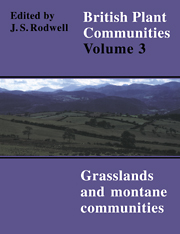Book contents
- Frontmatter
- Contents
- List of Figures
- Preface and Acknowledgements
- Preamble
- Mesotrophic Grasslands
- Community Descriptions
- Calcicolous Grasslands
- Community Descriptions
- Calcifugous Grasslands and Montane Communities
- Community Descriptions
- Index of Synonyms to Grasslands and Montane Communities
- Index of Species in Grasslands and Montane Communities
- Bibliography
CG14 - Dryas Octopetala-Silene Acaulis Ledge Community
Published online by Cambridge University Press: 04 July 2020
- Frontmatter
- Contents
- List of Figures
- Preface and Acknowledgements
- Preamble
- Mesotrophic Grasslands
- Community Descriptions
- Calcicolous Grasslands
- Community Descriptions
- Calcifugous Grasslands and Montane Communities
- Community Descriptions
- Index of Synonyms to Grasslands and Montane Communities
- Index of Species in Grasslands and Montane Communities
- Bibliography
Summary
Synonymy
Glen Lochay Dryas heath Poore & McVean 1957; Dryas-Salix reticulata nodum McVean & Ratcliffe 1962; Dryas-Carex rupestris nodum McVean & Ratcliffe 1962 p.p.; Salico-Dryadetum Shimwell 1968a; Cairn well Limestone vegetation Coker 1969 p.p.; Dryas octopetala localities Elkington 1971 p.p.; Dryas octopetala heath Ratcliffe 1977 p.p.; Cliff ledge communities Jermy et al. 1978p.p.; Dryas octopetala-Salix reticulata nodum Huntley 1979; Viola-Festuca-Agrostis nodum Huntley 1979p.p.; Alchemillaglabra-Sedum rosea nodum Huntley 1979 p.p.
Constant species
Alchemilla alpina, Campanula rotundifolia, Carex capillaris, C. pulicaris, Dryas octopetala, Festuca ovinalvivipara, Hieracium spp., Polygonum viviparum, Saxifraga aizoides, S. oppositifolia, Selaginella selaginoides, Silene acaulis, Thalictrum alpinum, Thymus praecox, Viola riviniana, Ctenidium molluscum, Ditrichum flexicaule, Hylocomium splendens, Rhytidiadelphus triquetrus, Tortella tortuosa.
Rare species
Alchemilla filicaulis ssp. filicaulis, Astragalus alpinus, Bartsia alpina, Carex atrata, C. capillaris, C. rupestris, C. vaginata, Cerastium alpinum, C. arcticum, Draba incana, Dryas octopetala, Euphrasia frigida, Minuartia sedoides, Orthilia secunda, Oxytropis halleri, Polystichum lonchitis, Potentilla crantzii, Pyrola rotundifolia, Salix arbuscula, S. lapponum, S. myrsinites, S. reticulata, Sesleria albicans, Tofieldia pusilia, Veronica fruticans.
Physiognomy
The Dryas-Silene community comprises rich, varied and luxuriant mixtures of dwarf shrubs, tall herbs, sedges and grasses among a carpet of cushion herbs and bryophytes. Stands are frequently small and fragmentary, the vegetation being usually disposed over the ledges of rock outcrops. Dryas octopetala is the most open and uneven cover of dwarf shrubs and it occurs here as taller and larger-leaved plants than those found in the Dryas-Carex heath and the Sesleria-Galium grassland, variation which reflects the lack of grazing in this community but which also seems to have some genetic basis (Elkington 1971). Then, there is commonly one (very occasionally more than one) of a number of rare Arctic-Alpine willows. Salix reticulata is the most frequently encountered and the cover of its low creeping branches can rival or exceed that of D. octopetala.
- Type
- Chapter
- Information
- British Plant Communities , pp. 267 - 274Publisher: Cambridge University PressPrint publication year: 1992



